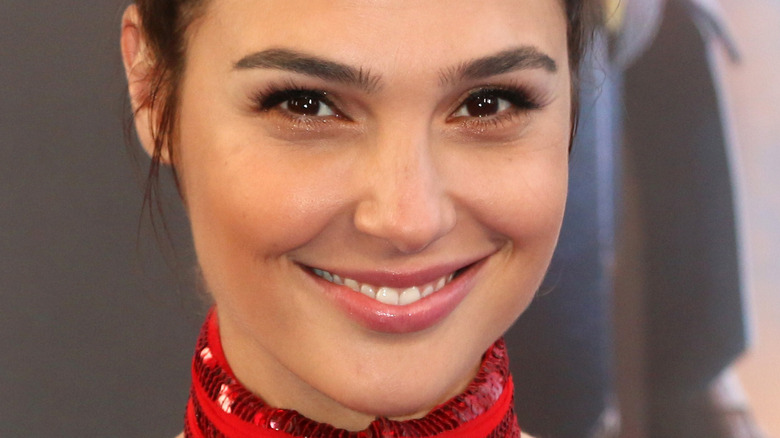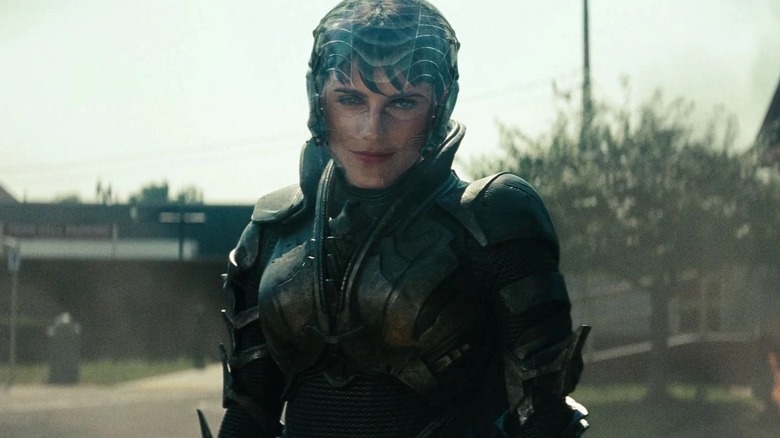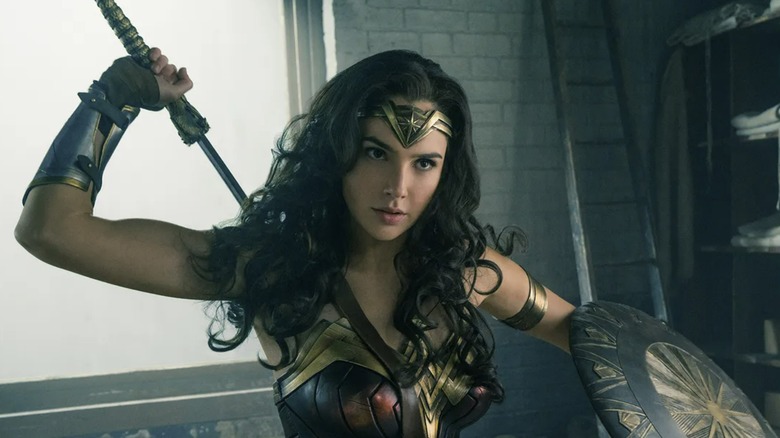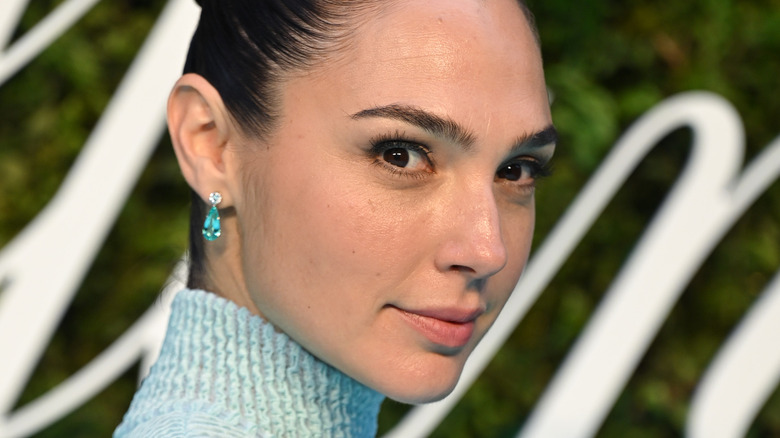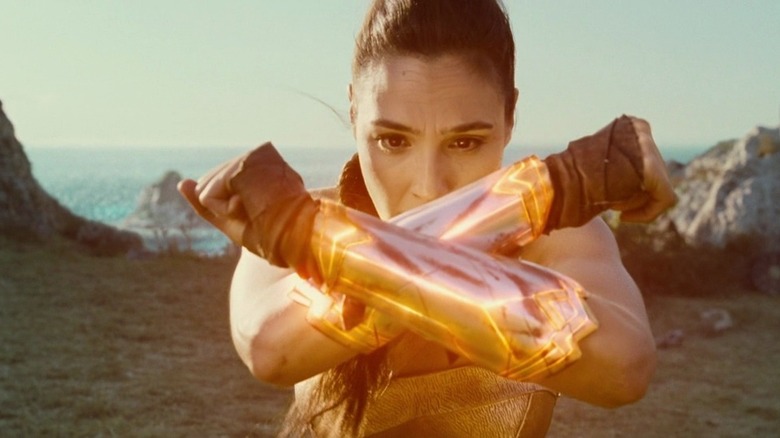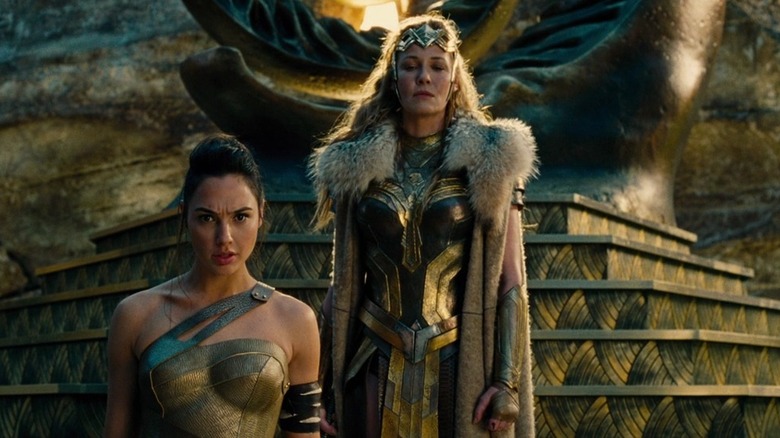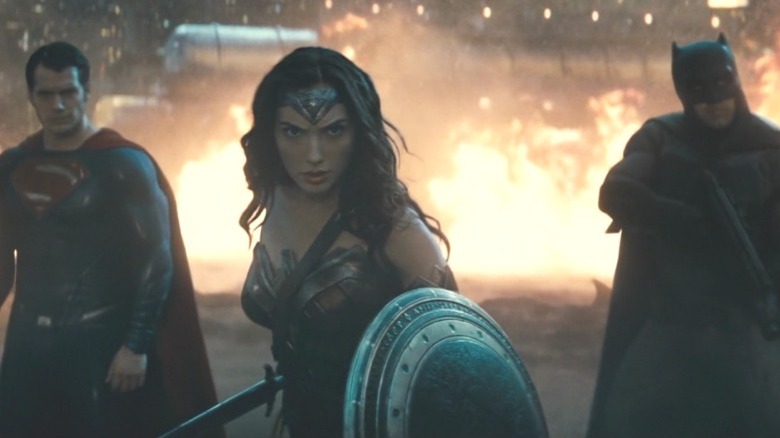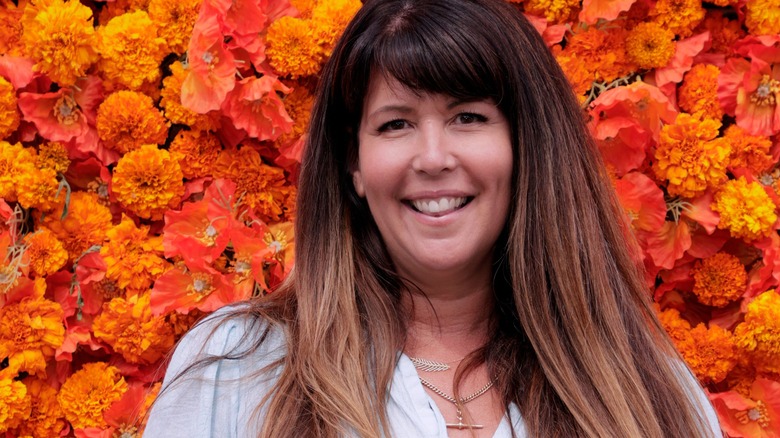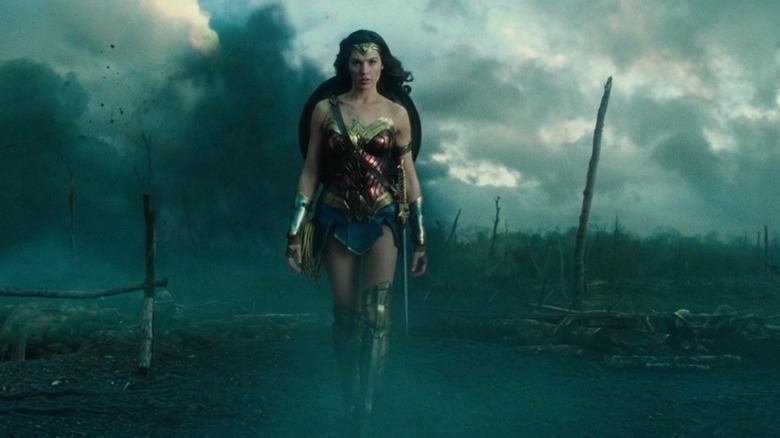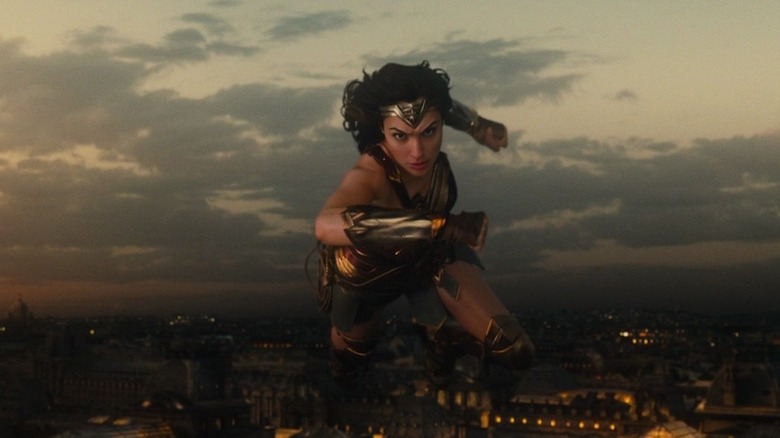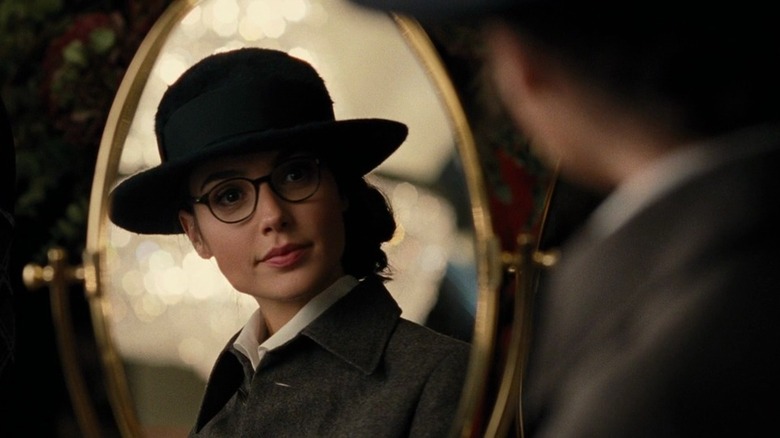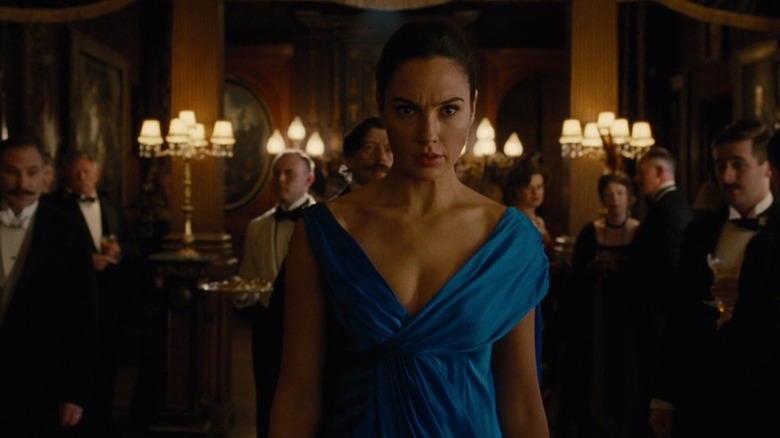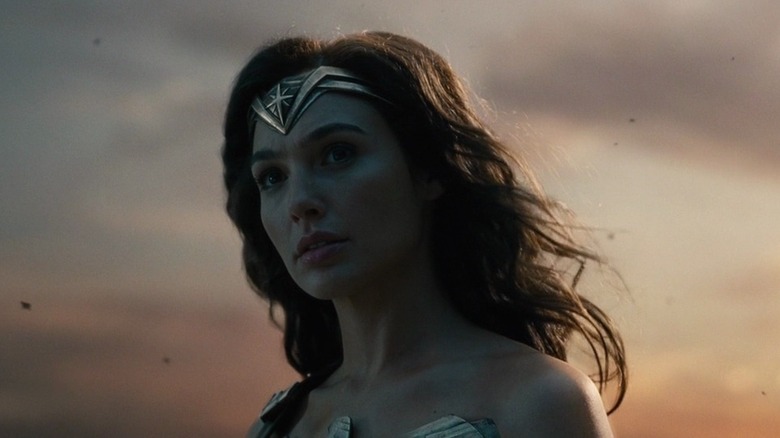The Untold Truth Of Gal Gadot's Wonder Woman
We may receive a commission on purchases made from links.
While Wonder Woman has existed in comics and various other media (like television cartoons and video games) since the 1940s, it wouldn't be until 2016 that the world got its first glimpse at a live-action movie version of the character. Portrayed by Gal Gadot, she arrived in the sprawling multimedia franchise known as the DC Extended Universe. This version of the character debuted in "Batman v Superman: Dawn of Justice" and went on to appear in subsequent crossover movies like "Justice League" and her solo features.
Considering that "Wonder Woman" is still the biggest DCEU film at the North American box office by a massive margin, it's clear that Gadot's interpretation of the character has become extremely popular and recognizable with the general public. The 75-year wait for this Amazonian warrior to make her way to movie theaters ended up being worth it.
However ubiquitous this incarnation of the superhero may be, the DCEU version of Wonder Woman still has lots of secrets that aren't common knowledge to the general public. These include a DC character that Gadot almost played instead of Wonder Woman, the comics that inspired the character's first solo feature, Gadot's difficulties in the reshoots for "Justice League," and more. Strap on your armor and prepare to confront the untold truth of the DCEU version of Wonder Woman.
Gal Gadot almost took another DC role instead
Through playing her in multiple solo adventures and DC ensemble movies, Gal Gadot has become deeply associated with the character of Wonder Woman. However, Gadot's presence in the DC Extended Universe almost started much earlier and would have precluded her from playing the princess of Themyscira. Speaking to Xnet, Gadot revealed that she was offered the part of Faora in "Man of Steel" years before she auditioned for the role of Wonder Woman. Faora, eventually played by Antje Traue, was one of the villains of "Man of Steel," a Kryptonian who served as the right-hand person of primary antagonist General Zod.
While she'll apparently turn up in some capacity in "The Flash," Faora initially appears to have been defeated for good at the end of "Man of Steel," sucked into a vortex that leads to the Phantom Zone. In addition to preventing her from playing Wonder Woman, taking on this role wouldn't have offered Gadot much of an opportunity for a lengthy stay in the DCEU. Luckily, Gadot was pregnant at the time the Faora part was offered to her, so she had to decline. Turning down this character may have seemed disappointing then, but it ended up being the right call in the long run for Gadot's career.
The casting speculation around Wonder Woman
It was 2013 when word began to spread across the globe that the leading lady role was being cast in what would become "Batman v Superman: Dawn of Justice." While at the time nobody would confirm what the part was, rumors ran rampant that it was for the character of Diana Prince/Wonder Woman. The DCEU's incarnation of this character was set to be the first live-action movie incarnation of Wonder Woman, a tremendous milestone that required very careful casting.
Variety broke the news, reporting that the finalists for the part were Elodie Yung, Olga Kurylenko, and the eventual choice for the part, Gal Gadot. The outlet also noted that Jaimie Alexander was heavily considered for the role, but her obligations to play Lady Sif in the Marvel Cinematic Universe cost her the chance.
Kurylenko told The Hollywood Reporter that her audition was shrouded in mystery. She also recalled how she was given an approximation of the character's superhero outfit to wear in the audition, but not Wonder Woman's actual attire. While Kurylenko ended up finishing in second place, the entire process confirmed that a live-action Wonder Woman would finally be coming to the big screen.
Gal Gadot's initial Wonder Woman contract was short
The 2010s saw many actors signing lengthy contracts to portray a single character in multiple superhero movies. While multi-film contracts for blockbuster actors had existed for decades, the age of "The Avengers" had substantially increased how many motion pictures people could get hitched for. Chris Evans, for instance, told Collider he signed a six-film contract when he agreed to portray Captain America, while Sebastian Stan was locked into a nine-movie contract once he was signed to play Bucky Barnes. Such contracts ensure casting continuity across several films and allow major performers to show up in titles beyond their solo franchises.
When Gal Gadot was announced as Wonder Woman, it was revealed that she too had signed a multi-movie contract to portray the character. However, her commitments paled in comparison to the requirements of other superhero movie contracts. Gadot was on the hook for three films, which she ended up fulfilling with "Batman v Superman: Dawn of Justice," "Wonder Woman," and "Justice League." Gadot stayed in the role beyond that initial three-film deal, with a much bigger payday for that extension. Gadot revealed to Elle that she secured a $10 million payday for "Wonder Woman 1984," a massive increase over her $300,000 payment for the first "Wonder Woman."
The studio was hesitant over a solo Wonder Woman movie
It was officially announced in early 2014 — after years of false starts and abandoned projects — that Gal Gadot was playing Wonder Woman in "Batman v Superman: Dawn of Justice." Even more exciting was that Gadot's role was not intended to be a one-off turn. It was revealed that Gadot has signed a three-movie deal to play Wonder Woman, with the other two titles being a "Justice League" movie and a solo Wonder Woman outing.
At the same time, out of an abundance of caution, the studio wanted to make sure audiences responded to Wonder Woman in "Dawn of Justice" before fully committing to more movies starring the character. Thankfully, this initial sense of hesitancy would eventually pass. Less than a year later, in October 2014, Warner Bros. announced that a solo Wonder Woman title was planned for June 2017 with Gadot in the lead role. The time had finally come for one of DC's legends to get her own feature film.
How Patty Jenkins felt about Zack Snyder casting Wonder Woman
When Patty Jenkins signed on to direct "Wonder Woman," a key part of the production was already finished for her. Zack Snyder and the team behind "Batman v Superman: Dawn of Justice" had already cast the titular role so that she could have a supporting role in Snyder's movie. Jenkins told Playboy (via IndieWire) that she was initially crushed that Wonder Woman had been cast without any input from her. Her reasoning was that Jenkins was certain she and the team behind "Batman v Superman" would never have made the same choice for the role.
However, Jenkins quickly became more and more convinced that Gadot was the right person for the part all along, once she began to interact with her. By the time she was helming "Wonder Woman," Jenkins became convinced that the "Batman v Superman" team had done a much better job at casting the role than she ever could have. Jenkins didn't think that she would have implemented such a global and comprehensive search, which would have never led her to Gadot. Though it initially seemed like a disappointing development, working with an already cast Wonder Woman turned out to be a blessing for director Patty Jenkins.
Gadot believed Wonder Woman loved peace...and a good fight
One of the most notable sequences in "Batman v Superman: Dawn of Justice" comes near the end, as the DC Trinity join forces to fight Doomsday. Batman, Superman, and Wonder Woman, all together for the first time in a live-action movie, are ready to take down this massive nemesis. During the ensuing skirmish, Doomsday tosses Wonder Woman into a wall, which inspires this Amazonian warrior not to back down in fear, but rather deliver a knowing smirk. She's far more ready for the battle ahead than this creature realizes. It's a small moment, but one that Gal Gadot saw as being important to understanding the nuances of Wonder Woman as a character.
Gadot noted to The Los Angeles Times that the Wonder Woman seen in "Dawn of Justice" still stood for elements like empathy and kindness despite being so battle-ready. However, Gadot also wanted to inject some nuance to reflect that Wonder Woman had been in plenty of battles in her centuries of existence. Through small moments like that climactic smirk, Gadot wanted to hint at the character's history and her readiness for combat when the time comes. These were the kinds of tiny details that Gadot saw as crucial to making sure that the first live-action incarnation of Wonder Woman was a nuanced character that audiences could relate to.
Why Patty Jenkins was perfect to direct Wonder Woman
Before she directed "Wonder Woman," Patty Jenkins only had one feature-length directorial credit to her name, "Monster." Beyond that, Jenkins had built up a reputation for her work on TV shows like "Arrested Development" and "The Killing." This eclectic collection of credits may not immediately scream that Jenkins was a perfect choice to helm "Wonder Woman," but she turned out to be a great fit for the project.
Speaking to Deadline, Gal Gadot and Patty Jenkins recalled how they bonded over their shared vision of "Wonder Woman" being a throwback to vintage blockbusters, one that had a complicated tone and left audiences with soaring hearts. But that shared vision wasn't the only way Gadot knew that Jenkins was meant to direct "Wonder Woman." After working with her on the set, Gadot also felt that the concrete creative vision that Jenkins carried on the "Wonder Woman" set, as well as her perfectionist tendencies, made her exactly right for this landmark tentpole.
The comic book influences of Wonder Woman's first movie
Wonder Woman has existed in the medium of comics since October 1941. In the decades since, she's had many different adventures and explored a variety of aesthetics. There isn't quite one vibe to all of Wonder Woman's comic book incarnations. She's very different in the 1940s, for instance, compared to her 1990s exploits. This meant that director Patty Jenkins had a variety of options for creative inspiration when it came time to make "Wonder Woman." There was no shortage of places for her to look for guidance on what Wonder Woman should be as a character.
Speaking on Twitter, Jenkins revealed that the very first comics from William Moulton Marston were extremely impactful on how she molded the story, along with the 1987-1992 run by George Perez. From there, Jenkins proceeded to pick and choose which comic runs she took mild inspiration from, though the works of Marston and Perez were the most influential. In a separate tweet, Jenkins also mentioned that a "New 52" comics storyline which revolved around Wonder Woman departing the island of Themyscira also proved to be extremely influential on her vision for the film.
Rather than be daunted by just how much printed material Wonder Woman had starred in over the years, Jenkins just ran with the varying interpretations of the character and leaned into all kinds of influences for Wonder Woman's first live-action solo movie.
The thought process behind Wonder Woman's costume
Bringing Wonder Woman to the big screen for the first time presented many challenges, but few were as difficult as trying to figure out what to do with the character's costume. Wonder Woman's attire has long been part of a trend of dressing up lady superheroes in scantily clad outfits to titillate male readers. However, the history of the character's iconic outfit is complicated by how the outfit was molded by the worldview of her creator, William Moulton Marston. The man believed Wonder Woman's costume reflected power over all others, a contrast to the subservient qualities ingrained in male-gaze depictions of women's superhero outfits.
These conflicting aspects of history were quietly acknowledged within the film version of Wonder Woman. Here, Diana Prince and her fellow warriors on Themyscira charge into battle in outfits that aren't as cheesecake as costumes they may have worn in the 1950s, but do carry some impractical elements, like the use of high heels. Patty Jenkins told Entertainment Weekly that this was a conscious choice meant to give lady audience members a character they could live vicariously through. In the words of Jenkins, who wouldn't want to be able to beat people up while also managing to not trip on high heels? Finding this personal angle for the costumes of Wonder Woman's world ensured that they could exist in the modern pop culture landscape without sacrificing all the qualities that made them so enduringly iconic.
Gadot's thoughts on how Wonder Woman evolved for WW84
You never want your superhero characters to get stale. Even the most beloved crime fighters can get boring if their status remains unchanged for too long. For Wonder Woman's second solo movie, "Wonder Woman 1984," Gal Gadot had some concrete ideas regarding how Wonder Woman could shift and evolve in her newest adventure.
Talking to Total Film (via GamesRadar), Gadot noted that the biggest shift in Diana Prince's personality from the first "Wonder Woman" to "Wonder Woman 1984" was that the character was much less naive than she was before. No longer a newcomer to the world beyond her isolated island home, Wonder Woman is a much more detailed and experienced character, a sharp contrast to the version of the character audiences saw in "Wonder Woman." Gadot saw this as a perfect way to reflect how "Wonder Woman 1984" is very much a standalone movie rather than a rehash of its predecessor. Even better, these tweaks ensured that this new incarnation of Wonder Woman wouldn't be running in place and risking audience alienation in the process.
Wonder Woman 1984 de-emphasized violence
According to books like "Wonder Woman: The Complete History," William Moulton Marston created Wonder Woman with the idea that there needed to be a superhero who primarily defeated her foes with love, not just through punching stuff or firing guns. This unique approach to the concept of a superhero inspired a pop culture icon and has, whether consciously or unconsciously, informed Wonder Woman's primary appearances ever since, as seen by how the creative team behind "Wonder Woman 1984" went out of their way to de-emphasize violence in the film's narrative.
Talking to JoBlo, Patty Jenkins noted that this aspect of "Wonder Woman 1984" was crystallized by the fact that there were zero deaths onscreen throughout the film. While other superhero movies demolish entire cities in the name of big-budget set pieces, "Wonder Woman 1984" made a deliberate effort to not have any collateral damage from its fantastical plot. Gadot noted that this lack of emphasis on violence also extended to not giving Wonder Woman her sword and shield in "Wonder Woman 1984." For Gadot, eschewing these weapons was a clear sign of how Wonder Woman's priorities lie in empathy and kindness, not slaughter. Through these choices in the making of "Wonder Woman 1984," this 2020 sequel could live up to the ideals of Marston's vision for Wonder Woman from decades earlier.
Gadot's difficulties in the Justice League reshoots
In hindsight, nobody seemed to have a good time on the reshoots for the 2017 movie "Justice League." Overseen by director Joss Whedon, these reshoots have become infamous for the horror stories actors have shared about their experiences on the set. Ben Affleck, for instance, told The Los Angeles Times that he was so miserable during the reshoots that it soured him on the idea of playing Bruce Wayne/Batman long-term. Meanwhile, Ray Fisher made several allegations of experiencing racially insensitive behavior on the set of these reshoots. Even Gal Gadot was not exempt from the hardships of this stretch of the "Justice League" production.
Speaking to The Los Angeles Times, Gadot revealed that she had a separate bad experience on the set of "Justice League" during its lengthy reshoots that involved Whedon. She did note that she complained about this problem and that it was immediately sorted out by Warner Bros. brass. She didn't divulge details about what the incident was, but this anecdote reflects just how miserable the reshoots were for all the main actors. Even a performer associated with hope, like Gadot, was not impervious to the brutal and cruel realities of these reshoots.
